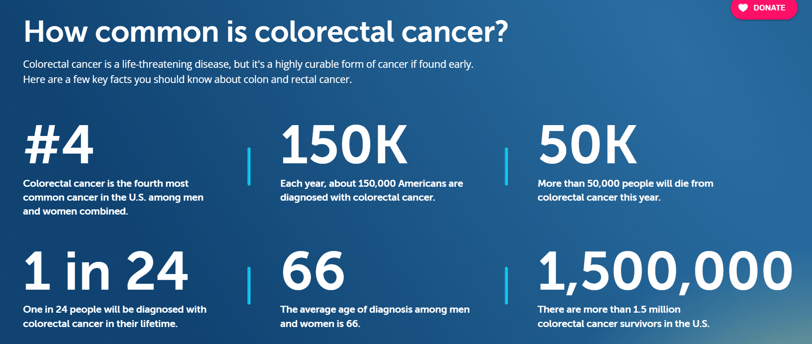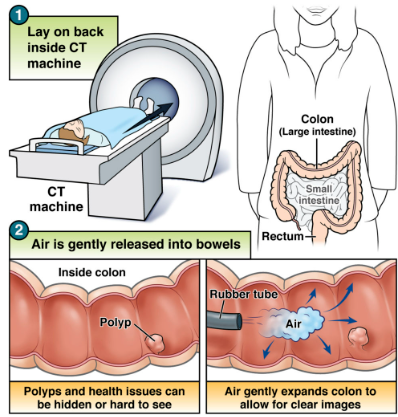The Underutilization of CT Colonography: A Hidden Gem in Colorectal Cancer Screenings
Colorectal cancer (CRC) remains a significant health concern, with more than 50,000 people dying from colon cancer each year. Given that colon cancer is typically a slow-growing malignancy, there is a substantial window of opportunity for early detection and intervention. While traditional colonoscopy has long been the go-to screening tool, CT Colonography (CTC)—often known as "virtual colonoscopy"—offers a minimally invasive alternative that could dramatically impact survival rates if more widely adopted. Today, we’re diving into why this innovative screening method isn’t used as much as it should be and what can be done to change that.


What is CT Colonography?
CT Colonography is a modern imaging test that creates a detailed, 3D view of the colon and rectum using computed tomography (CT) scans. Unlike the conventional colonoscopy, CTC is less invasive, typically doesn’t require sedation, and is completed in about 10-15 minutes. It not only screens for colorectal cancer and large polyps but can also detect extracolonic abnormalities—providing a broader health check in one go.
The Clear Benefits of CT Colonography
1. Minimally Invasive and Quick
Less Invasive: CTC doesn’t require sedation or the insertion of a long colonoscope throughout the colon, reducing discomfort and risk.
Fast Procedure: With an exam time of roughly 10-15 minutes, it’s an attractive option for busy patients.
2. Dual Diagnostic Value
Extra Screening: In addition to detecting polyps and cancer, CTC can reveal other potential issues in nearby organs like the kidneys and adrenal glands.
3. Patient Preference
Comfort Matters: Many patients prefer the idea of a "virtual" exam over a traditional colonoscopy, particularly if they are wary of invasive procedures.
The Critical Need for Better Screening
Given that colon cancer is a slow-growing disease, early detection plays a pivotal role in reducing mortality. With more than 50,000 deaths each year attributed to colon cancer, improving screening accessibility and efficiency is crucial. CT Colonography, with its rapid and less invasive approach, has the potential to catch cancers early when they are most treatable—potentially saving countless lives.
Barriers to Widespread Adoption
Despite these advantages, CT Colonography isn’t the first choice for many. Here are some of the key reasons:
Limited Awareness and Training
Provider Knowledge: Many healthcare professionals are either not fully aware of CTC’s benefits or lack the necessary training to interpret the scans accurately.
Radiologist Expertise: Not all radiologists are experienced in reading CTC images, which can lead to missed opportunities for early diagnosis and require longer reading times, which diminishes a radiologists efficiency and work rate.
Reimbursement and Policy Issues
Insurance Hurdles: In many regions, CTC isn’t covered by insurance, or the reimbursement rates are too low, discouraging both providers and patients from opting for this method.
Policy Gaps: Without strong policy support or national screening programs endorsing CTC, its integration into regular screening regimens remains limited.
Perceived Limitations
No Therapeutic Intervention: Unlike traditional colonoscopy, if polyps are detected during CTC, a follow-up colonoscopy is necessary to remove them. This two-step process can deter both patients and clinicians.
Risk of Incidental Findings: The discovery of incidental abnormalities might lead to additional tests, potentially increasing patient anxiety and healthcare costs.
Patient Misconceptions
Preparation Similarities: Many patients assume that the bowel preparation required for CTC is as burdensome as that for a traditional colonoscopy.
Efficacy Concerns: Some believe that CTC might not be as effective, even though studies have shown it to be a reliable screening tool.
Strategies to Boost CT Colonography Utilization
If we’re going to harness the full potential of CT Colonography, a multi-pronged approach is necessary:
1. Education and Advocacy
For Providers: Increase training opportunities and awareness campaigns that highlight CTC’s benefits and its role in early CRC detection.
For Patients: Develop clear, accessible educational materials that explain the advantages of CTC and dispel common myths.
For Radiologists: Develop clear, accessible educational materials that improve reading efficiency and times for these studies. Radiologists must feel confident to read the studies quickly and effectively.
2. Policy and Reimbursement Reforms
Insurance Coverage: Advocate for broader insurance acceptance and better reimbursement rates for CTC.
National Guidelines: Encourage healthcare policymakers to integrate CTC into official colorectal cancer screening programs.
3. Technological Advancements
Improved Prep: Research and develop methods to minimize or eliminate the need for extensive bowel preparation. Continue testing with the laxative pill combinations that have shown promise and are generally more acceptable to patients.
Enhanced Imaging: Continue to invest in Deep learning driven automated detection algorithms to support radiologists and increase diagnostic accuracy.
4. Multi-Modality Screening Programs
Customized Screening: Position CTC as one of several screening options, allowing patients to choose the method that best suits their comfort level and medical needs.
Conclusion
CT Colonography holds tremendous promise as a screening tool for colorectal cancer, yet its potential remains largely untapped. With more than 50,000 people dying from colon cancer annually, the importance of early detection cannot be overstated. The slow-growing nature of colon cancer means that there is a significant opportunity for interventions that can dramatically improve outcomes. Unfortunately, the underutilization of CTC is not due to a lack of efficacy, but rather a complex mix of limited awareness, reimbursement issues, and procedural misconceptions.
By educating healthcare providers and patients, advocating for better policies, and embracing technological innovations, we can overcome these barriers and make CT Colonography a more prominent player in the fight against colorectal cancer. Early detection saves lives—and embracing all available screening options, including CT Colonography, is a step in the right direction.
Let's continue the conversation and work towards a future where every patient has access to the most effective, least invasive screening methods available.


